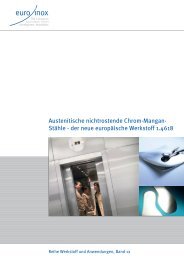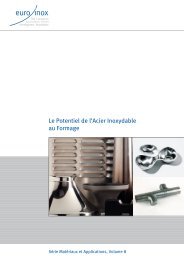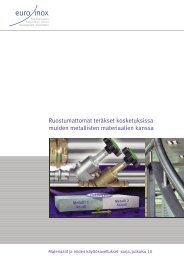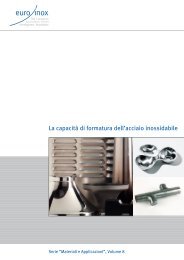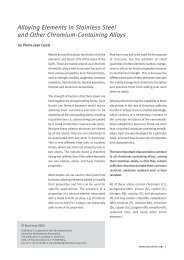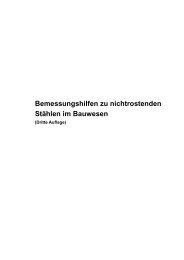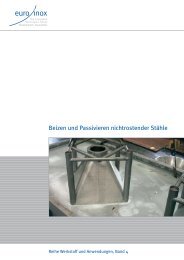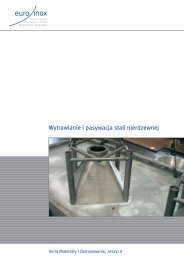Stainless Steel - The Safe Choice - Euro Inox
Stainless Steel - The Safe Choice - Euro Inox
Stainless Steel - The Safe Choice - Euro Inox
You also want an ePaper? Increase the reach of your titles
YUMPU automatically turns print PDFs into web optimized ePapers that Google loves.
Grade Corrosion resistance Ni release in Clinical test Grouping<br />
(passivity) synthetic (allergic<br />
sweat reactions)<br />
AISI 430/1.4016<br />
AISI 304/1.4301<br />
(µg/cm2/week) (%)<br />
AISI 316L/1.4404 Yes < 0.05 0 1<br />
AISI 303/1.4305 Weak ≈ 0.5 14 2<br />
Ni-plated steel No > 70 96 3<br />
5.2 <strong>Stainless</strong> steels in contact with food<br />
<strong>Stainless</strong> steel plays a vital role in the production<br />
and processing of food and beverages.<br />
For over 70 years stainless steel has<br />
been used in the preparation, processing and<br />
transport of food products to ensure a high<br />
standard of quality. It does not affect the<br />
taste of food and drink. <strong>Stainless</strong> steel has a<br />
high resistance to cleaning agents, disinfectants<br />
and sterilising agents such as pressurised<br />
steam.<br />
Chromium and nickel release from stainless<br />
steel in contact with food or during its processing,<br />
storage and during meal preparation<br />
and cooking is, in most cases, negligible.<br />
Experiments on pick-up of chromium and<br />
nickel from stainless steel utensils have been<br />
conducted using acid fruit (14). Experiments<br />
using AISI 430Ti/1.4510 and AISI 444/1.4521<br />
(ferritic grades) and AISI 304/1.4301 (austenitic<br />
grade) in a boiling acetic acid solution<br />
showed that chromium and nickel release is<br />
very low. <strong>The</strong> concentration observed were<br />
close to the detection limits i.e. 30 µg/l for<br />
chromium and 10 µg/l for nickel.<br />
A recent field investigation (15) of actual<br />
operation using meals cooked in glass,<br />
ferritic (AISI 436/1.4526) and austenitic<br />
(AISI 304/1.4301) stainless steel pans<br />
showed that the levels of nickel and chromium<br />
fall either within or very close to the<br />
range of chromium and nickel reported in the<br />
literature.<br />
Statistical tests showed that nickel and chromium<br />
intake from meals cooked in stainless<br />
steel utensils (in austenitic 18.2 % Cr - 8.6 %<br />
Ni/304 grade and in ferritic 16.6 % Cr - 1.0 %<br />
Mo niobium stabilised/436 grade) was insignificant.<br />
It is clear that the use of stainless steel<br />
cooking utensils does not provide a significant<br />
source of dietary chromium or<br />
nickel and there is no advantage to be<br />
gained by nickel-sensitive persons who<br />
suffer from contact allergy by avoiding<br />
the use of stainless steel utensils.<br />
SAFE STAINLESS STEEL<br />
Table 3: <strong>Stainless</strong> steel<br />
in prolonged contact<br />
with skin and the Ni<br />
contact dermatitis issue.<br />
© <strong>Euro</strong> <strong>Inox</strong> 2002 www.euro-inox.org · 7



